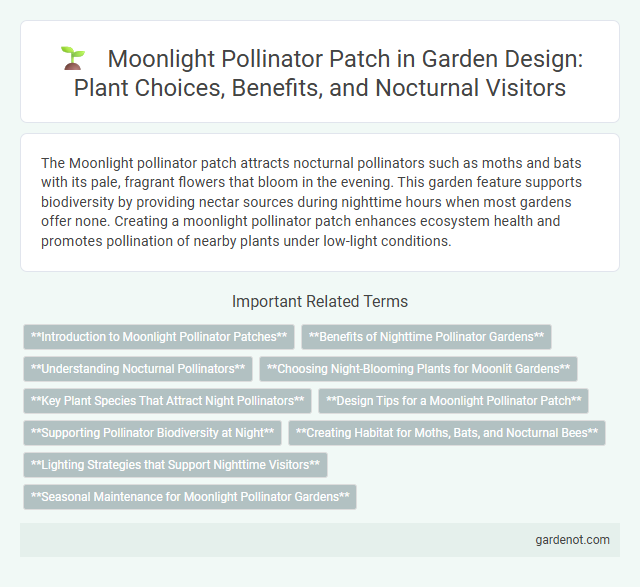The Moonlight pollinator patch attracts nocturnal pollinators such as moths and bats with its pale, fragrant flowers that bloom in the evening. This garden feature supports biodiversity by providing nectar sources during nighttime hours when most gardens offer none. Creating a moonlight pollinator patch enhances ecosystem health and promotes pollination of nearby plants under low-light conditions.
Introduction to Moonlight Pollinator Patches
Moonlight pollinator patches are designed to attract and support nocturnal pollinators such as moths and bats by using night-blooming flowers rich in nectar and pollen. These patches feature plants like evening primrose, moonflowers, and night-blooming jasmine that emit strong fragrances and pale colors visible in low light. Incorporating moonlight pollinator patches enhances biodiversity, supports ecosystem health, and improves pollination for nearby crops and gardens.
Benefits of Nighttime Pollinator Gardens
Nighttime pollinator gardens like the Moonlight Pollinator Patch support nocturnal pollinators such as moths, bats, and certain beetles, enhancing biodiversity and ecosystem resilience. These gardens improve pollination efficiency by extending activity hours beyond daylight, which increases fruit and seed production for various plants. They also contribute to urban cooling and reduced light pollution by using native, night-blooming flowers that attract essential pollinators while minimizing energy consumption.
Understanding Nocturnal Pollinators
Nocturnal pollinators such as moths, bats, and certain beetles play a crucial role in maintaining biodiversity within the Moonlight pollinator patch. These species are adapted to navigate and forage in low-light conditions, relying on scent and pale-colored flowers that emit strong fragrances at night. Supporting nocturnal pollinators enhances plant reproduction cycles and promotes ecological balance by facilitating pollination when diurnal pollinators are inactive.
Choosing Night-Blooming Plants for Moonlit Gardens
Selecting night-blooming plants like evening primrose, moonflower, and night phlox enhances the Moonlight Pollinator Patch by attracting nocturnal pollinators such as moths and bats. These species emit strong fragrances and display pale or white blossoms that reflect moonlight, improving visibility for night pollinators. Incorporating native night-blooming plants supports local biodiversity and ensures successful pollination in moonlit gardens.
Key Plant Species That Attract Night Pollinators
Moonlight pollinator patches thrive with key plant species like evening primrose, moonflower, and night-blooming jasmine, which emit strong scents and pale or white flowers to attract moths and bats. These plants provide essential nectar and pollen resources during nighttime hours, supporting nocturnal pollinators critical for ecosystem health. Incorporating such species enhances biodiversity and ensures pollination continuity after sunset.
Design Tips for a Moonlight Pollinator Patch
In designing a Moonlight pollinator patch, prioritize planting night-blooming flowers such as evening primrose, moonflower, and night phlox to attract nocturnal pollinators like moths and bats. Incorporate soft, white or pale-colored blossoms to enhance visibility in low light and create a calming ambiance for nighttime visitors. Ensure the garden includes a water source and avoids pesticides to foster a healthy habitat for pollinators active after dusk.
Supporting Pollinator Biodiversity at Night
Moonlight pollinator patches provide vital habitats for nocturnal pollinators, including moths, bats, and night-flying beetles that significantly contribute to ecosystem health. By incorporating night-blooming plants like evening primrose, moonflowers, and night-scented stock, these gardens enhance nectar availability during nighttime hours, supporting pollinator biodiversity. Conserving diverse night-active species within these patches promotes balanced pollination networks and strengthens ecosystem resilience.
Creating Habitat for Moths, Bats, and Nocturnal Bees
Moonlight pollinator patches provide essential habitat for nocturnal pollinators such as moths, bats, and night-flying bees by incorporating native night-blooming plants rich in nectar and pollen. These habitats support biodiversity by offering shelter and foraging resources during nighttime hours, crucial for the survival of these often-overlooked species. Enhancing moonlight gardens with white or pale-colored flowers improves visibility for nocturnal pollinators, facilitating effective pollination and ecosystem health.
Lighting Strategies that Support Nighttime Visitors
Moonlight pollinator patches utilize specialized LED lighting with low blue light emissions to minimize disruption to nocturnal insects such as moths and beetles. Strategic placement of dim, warm-colored lights preserves natural night conditions while enhancing visibility for night-flying pollinators. Incorporating motion sensors and timers further reduces light pollution, promoting healthy nighttime pollination activities.
Seasonal Maintenance for Moonlight Pollinator Gardens
Seasonal maintenance for Moonlight Pollinator Gardens includes timely pruning of native flowering plants to promote vigorous growth and extended blooming periods. Applying organic mulch in early spring helps retain soil moisture and suppress weeds, creating an ideal habitat for nocturnal pollinators. Regular monitoring for invasive species and replanting native pollinator-friendly flora ensures sustained biodiversity and ecosystem health throughout the year.
Moonlight pollinator patch Infographic

 gardenot.com
gardenot.com